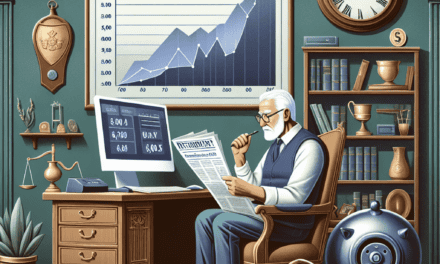“Invest Around the Clock: U.S. Stocks Set to Go 24/7!”
Introduction
U.S. stocks may soon experience a significant shift in trading dynamics as the possibility of nearly 24/7 trading becomes more feasible. This development is driven by advancements in technology, increasing demand for greater market accessibility, and the globalization of financial markets. By extending trading hours, investors could benefit from enhanced flexibility, allowing them to respond more swiftly to global events and economic data releases that occur outside traditional market hours. This change could also attract a broader range of participants, including international investors and retail traders, thereby increasing liquidity and potentially reducing volatility. As the financial industry explores the logistics and implications of such a transformation, nearly round-the-clock trading could redefine the landscape of U.S. stock markets, offering new opportunities and challenges for market participants.
Impact Of 24/7 Trading On Market Volatility
The prospect of U.S. stocks trading nearly 24/7 is a development that could significantly alter the landscape of financial markets. As technology continues to advance and global connectivity increases, the demand for round-the-clock trading has grown. This shift towards extended trading hours is poised to impact market volatility in several ways, necessitating a closer examination of its potential effects.
To begin with, the introduction of nearly continuous trading hours could lead to increased liquidity in the markets. With more opportunities to buy and sell stocks, investors may find it easier to execute trades without causing significant price fluctuations. This enhanced liquidity could, in theory, reduce volatility by smoothing out price movements that might otherwise occur during the limited trading hours of traditional markets. However, the reality may be more complex, as increased trading hours could also attract a wider range of participants, including those with varying risk appetites and strategies.
Moreover, the presence of global investors in a 24/7 trading environment could amplify the influence of international events on U.S. markets. Currently, significant geopolitical or economic developments occurring outside of U.S. trading hours can lead to sharp market movements when the market opens. With nearly continuous trading, these events could be priced into the market more gradually, potentially reducing the severity of opening gaps. On the other hand, the constant flow of information and trading activity might lead to heightened sensitivity to news, thereby increasing short-term volatility as investors react in real-time to global developments.
In addition to these factors, the role of algorithmic and high-frequency trading in a 24/7 market warrants consideration. These trading strategies, which rely on speed and efficiency, could become even more prevalent with extended hours. While they can contribute to market liquidity, they may also exacerbate volatility during periods of market stress. The rapid execution of trades by algorithms can lead to sudden and significant price swings, particularly if multiple algorithms respond similarly to market signals. As such, regulators and market participants will need to carefully monitor the impact of these strategies in a continuously operating market.
Furthermore, the psychological aspect of nearly 24/7 trading cannot be overlooked. The constant availability of the market may lead to increased stress and pressure on individual investors, who might feel compelled to monitor their portfolios more frequently. This heightened engagement could result in more impulsive trading decisions, potentially increasing volatility as investors react emotionally to market movements. Education and tools to help investors manage their behavior in this new environment will be crucial in mitigating these effects.
Finally, it is important to consider the potential impact on market infrastructure and regulatory frameworks. The transition to nearly continuous trading will require significant upgrades to technology and systems to ensure stability and security. Additionally, regulators will need to adapt their oversight to address the challenges posed by extended trading hours, such as ensuring fair access and preventing market manipulation.
In conclusion, while the move towards nearly 24/7 trading in U.S. stocks presents opportunities for increased liquidity and more efficient price discovery, it also poses challenges that could influence market volatility. The interplay of global participation, algorithmic trading, investor behavior, and regulatory adaptation will shape the extent to which volatility is affected. As the market evolves, stakeholders must remain vigilant in addressing these complexities to foster a stable and resilient trading environment.
How 24/7 Trading Could Affect Retail Investors
The concept of U.S. stocks trading nearly 24/7 is gaining traction, promising to reshape the landscape of retail investing. As technology advances and global markets become increasingly interconnected, the traditional trading hours of 9:30 a.m. to 4:00 p.m. Eastern Time may soon become a relic of the past. This shift towards extended trading hours could have profound implications for retail investors, offering both opportunities and challenges.
To begin with, the prospect of 24/7 trading could democratize access to the stock market. Retail investors, who often juggle investing with full-time jobs and other commitments, would benefit from the flexibility to trade at any time. This could lead to increased participation from individuals who previously found it difficult to engage with the market during standard hours. Moreover, the ability to react to global events in real-time could empower retail investors to make more informed decisions, potentially leveling the playing field with institutional investors who have traditionally had the upper hand.
However, while the allure of round-the-clock trading is enticing, it also presents certain risks. One significant concern is the potential for increased volatility. Extended trading hours could lead to thinner markets, as not all investors will be active at all times. This could result in larger price swings, making it more challenging for retail investors to execute trades at desired prices. Additionally, the constant availability of trading could encourage impulsive decision-making, as investors might feel compelled to react immediately to news or market movements without fully considering the implications.
Furthermore, the infrastructure required to support 24/7 trading is another critical factor to consider. Brokerages and trading platforms would need to invest in robust systems capable of handling the increased volume and complexity of transactions. This could lead to higher costs for retail investors, as these expenses may be passed down in the form of fees or commissions. Moreover, the need for continuous customer support and risk management could strain resources, potentially impacting the quality of service provided to retail clients.
Despite these challenges, the potential benefits of 24/7 trading cannot be overlooked. For instance, it could enhance liquidity by attracting a broader range of participants, including international investors who operate in different time zones. This increased liquidity could, in turn, lead to more efficient price discovery, benefiting all market participants. Additionally, the ability to trade around the clock could foster innovation in financial products and services, as firms seek to capitalize on the new opportunities presented by an always-open market.
In conclusion, while the transition to nearly 24/7 trading in U.S. stocks presents both opportunities and challenges for retail investors, it is a development that warrants careful consideration. The potential for increased accessibility and participation must be weighed against the risks of heightened volatility and infrastructure demands. As the market evolves, retail investors will need to adapt to this new environment, developing strategies to navigate the complexities of a continuously operating market. Ultimately, the success of 24/7 trading will depend on the ability of market participants, regulators, and technology providers to address these challenges while maximizing the benefits for all investors.
The Role Of Technology In Enabling 24/7 Stock Trading
The advent of technology has consistently reshaped the landscape of financial markets, and the potential for U.S. stocks to trade nearly 24/7 is a testament to this ongoing evolution. As investors increasingly demand more flexibility and accessibility, technological advancements are paving the way for a new era in stock trading. This shift towards round-the-clock trading is not merely a futuristic concept but a tangible possibility, driven by the integration of sophisticated technologies that enhance market efficiency and accessibility.
To begin with, the proliferation of high-speed internet and the development of advanced trading platforms have significantly contributed to the feasibility of 24/7 stock trading. These platforms, equipped with robust algorithms and real-time data analytics, allow traders to execute transactions with unprecedented speed and accuracy. As a result, investors can respond to global events and market fluctuations instantaneously, regardless of traditional trading hours. This capability is particularly crucial in a globalized economy where financial markets are interlinked, and events in one part of the world can have immediate repercussions elsewhere.
Moreover, the rise of artificial intelligence and machine learning has further bolstered the potential for continuous trading. These technologies enable the analysis of vast amounts of data to identify patterns and predict market trends, thereby facilitating informed decision-making at any hour. Automated trading systems, powered by AI, can operate without human intervention, executing trades based on pre-set criteria and market conditions. This automation not only increases efficiency but also reduces the risk of human error, making 24/7 trading a more viable option.
In addition to these technological advancements, the growing popularity of cryptocurrencies has also played a role in pushing the boundaries of traditional trading hours. Cryptocurrency markets operate 24/7, setting a precedent for continuous trading and highlighting the demand for such flexibility among investors. As more individuals become accustomed to the idea of trading at any time, there is a natural inclination for stock markets to follow suit. This shift is further supported by the increasing number of retail investors who seek the convenience of trading outside conventional hours, driven by their diverse schedules and global perspectives.
However, transitioning to nearly 24/7 stock trading is not without its challenges. Market infrastructure must be robust enough to handle the increased volume and complexity of transactions. Additionally, regulatory frameworks need to adapt to ensure fair and transparent trading practices around the clock. Despite these hurdles, the potential benefits of extended trading hours are significant. Investors would have greater opportunities to manage their portfolios and mitigate risks, while markets could become more liquid and efficient.
Furthermore, the role of technology in enabling 24/7 stock trading extends beyond mere convenience. It represents a democratization of financial markets, providing access to a broader range of participants and fostering a more inclusive investment environment. As technology continues to advance, it is likely that the barriers to continuous trading will diminish, paving the way for a new standard in stock market operations.
In conclusion, the prospect of U.S. stocks trading nearly 24/7 is increasingly within reach, thanks to the transformative power of technology. As high-speed internet, AI, and automated systems continue to evolve, they are reshaping the financial landscape and challenging traditional notions of market operations. While there are obstacles to overcome, the potential for enhanced market efficiency and accessibility is undeniable, heralding a new era in stock trading that aligns with the demands of a globalized and technologically driven world.
Potential Benefits And Drawbacks Of 24/7 Stock Trading

The concept of U.S. stocks trading nearly 24/7 is gaining traction, promising to revolutionize the financial markets by aligning them more closely with the global economy’s round-the-clock nature. This potential shift could offer numerous benefits, yet it also presents several drawbacks that warrant careful consideration. As the world becomes increasingly interconnected, the demand for continuous trading has grown, driven by the desire for greater flexibility and accessibility. One of the primary advantages of 24/7 stock trading is the ability to respond to global events in real-time. Currently, significant news occurring outside of regular trading hours can lead to volatile market openings, as investors rush to adjust their positions based on overnight developments. By allowing continuous trading, markets could potentially absorb and react to information more gradually, reducing the likelihood of sharp price swings and enhancing overall market stability.
Moreover, extended trading hours could democratize access to the stock market, particularly for retail investors who may not have the flexibility to trade during traditional hours due to work or other commitments. This increased accessibility could lead to greater participation in the stock market, fostering a more inclusive financial environment. Additionally, continuous trading could enhance liquidity, as the constant availability of buyers and sellers might reduce bid-ask spreads, thereby lowering transaction costs for investors.
However, the transition to nearly 24/7 trading is not without its challenges. One significant concern is the potential for increased market volatility. While continuous trading might mitigate some volatility by allowing for more gradual price adjustments, it could also exacerbate it by encouraging speculative trading and short-termism. The constant availability of trading opportunities might tempt investors to make impulsive decisions based on incomplete information, leading to erratic market behavior.
Furthermore, the implementation of 24/7 trading would require substantial technological and regulatory adjustments. Trading platforms and exchanges would need to upgrade their systems to handle the increased volume and ensure robust cybersecurity measures are in place to protect against potential threats. Regulatory bodies would also need to adapt their oversight mechanisms to monitor markets effectively around the clock, ensuring fair and transparent trading practices.
Another potential drawback is the impact on market participants, particularly those working in the financial industry. The shift to continuous trading could lead to increased stress and burnout among traders and analysts, who may feel compelled to remain constantly vigilant to keep up with market developments. This could necessitate changes in work culture and practices, such as implementing shift work or leveraging artificial intelligence to manage trading activities during off-peak hours.
In conclusion, while the prospect of nearly 24/7 stock trading in the U.S. presents exciting opportunities for greater market efficiency and accessibility, it also poses significant challenges that must be carefully addressed. Balancing the benefits of continuous trading with the potential risks will require thoughtful consideration and collaboration among market participants, regulators, and technology providers. As the financial landscape continues to evolve, the move towards 24/7 trading may become an inevitable step in aligning the U.S. stock market with the demands of a globalized economy. However, ensuring that this transition is executed smoothly and responsibly will be crucial in maximizing its potential benefits while minimizing its drawbacks.
Comparison Of U.S. Stock Market With Cryptocurrency Markets
The U.S. stock market, a cornerstone of global finance, has long been characterized by its structured trading hours, typically operating from 9:30 AM to 4:00 PM Eastern Time on weekdays. This schedule, while traditional, contrasts sharply with the cryptocurrency markets, which operate 24/7, offering continuous trading opportunities. As the financial landscape evolves, there is growing speculation that U.S. stocks may soon adopt a nearly round-the-clock trading model, akin to their cryptocurrency counterparts. This potential shift could significantly alter the dynamics of stock trading, bringing both opportunities and challenges.
Cryptocurrency markets have set a precedent for continuous trading, providing investors with the flexibility to react to news and market developments at any time. This constant availability has attracted a new generation of traders who value the ability to manage their investments without the constraints of traditional market hours. In comparison, the U.S. stock market’s limited hours can sometimes lead to volatility, as investors rush to execute trades at market open or close, often in response to overnight news or global events. Extending trading hours could mitigate such volatility by allowing for a more gradual response to information.
Moreover, the global nature of financial markets today means that events in one part of the world can have immediate implications elsewhere. Cryptocurrency markets, with their 24/7 operation, are inherently more responsive to such global developments. If U.S. stocks were to trade nearly around the clock, it would enable investors to respond more swiftly to international news, potentially leading to more efficient price discovery. This could enhance the competitiveness of U.S. markets, attracting more global investors who seek the flexibility and immediacy that continuous trading offers.
However, transitioning to a nearly 24/7 trading model is not without its challenges. One significant concern is the potential for increased market manipulation. Cryptocurrency markets, despite their advantages, have faced criticism for being susceptible to price manipulation due to their relatively lower liquidity compared to traditional stock markets. If U.S. stocks were to trade continuously, regulators would need to implement robust measures to prevent similar issues, ensuring that extended trading hours do not compromise market integrity.
Additionally, the infrastructure required to support nearly round-the-clock trading is substantial. Stock exchanges, brokerage firms, and other market participants would need to invest in technology and staffing to accommodate extended hours. This could lead to increased operational costs, which may be passed on to investors in the form of higher fees. Balancing these costs with the benefits of extended trading hours will be a critical consideration for market stakeholders.
Furthermore, the human element of trading cannot be overlooked. While technology has enabled automated trading and algorithmic strategies, many investors still rely on human judgment and expertise. Extended trading hours could place additional demands on traders and analysts, potentially leading to burnout and decreased performance. Finding ways to support the well-being of market participants will be essential in any transition to a nearly 24/7 trading model.
In conclusion, while the prospect of U.S. stocks trading nearly 24/7 presents exciting opportunities for increased flexibility and global competitiveness, it also poses significant challenges that must be carefully addressed. By learning from the experiences of cryptocurrency markets and implementing appropriate safeguards, the U.S. stock market could successfully navigate this transition, ultimately benefiting investors and enhancing its role in the global financial ecosystem.
Regulatory Challenges In Implementing 24/7 Stock Trading
The prospect of U.S. stocks trading nearly 24/7 is an intriguing development that has captured the attention of investors, regulators, and financial institutions alike. As the global financial landscape becomes increasingly interconnected, the demand for continuous trading has grown, driven by the desire to capitalize on market-moving news and events that occur outside traditional trading hours. However, the implementation of a nearly round-the-clock trading system is fraught with regulatory challenges that must be carefully navigated to ensure market stability, investor protection, and fair competition.
To begin with, one of the primary regulatory challenges in implementing 24/7 stock trading is ensuring market integrity. The Securities and Exchange Commission (SEC), which oversees the U.S. stock market, has a mandate to maintain fair and orderly markets. Extending trading hours could potentially increase the risk of market manipulation and volatility, particularly during periods of low liquidity. Regulators would need to establish robust surveillance mechanisms to monitor trading activity around the clock, identifying and addressing any suspicious behavior promptly. This would likely require significant investment in technology and human resources, as well as close collaboration with exchanges and other market participants.
Moreover, investor protection is a critical concern that regulators must address in the context of extended trading hours. Retail investors, who may not have the same access to information and resources as institutional investors, could be at a disadvantage in a 24/7 trading environment. To mitigate this risk, regulators might consider implementing measures such as enhanced disclosure requirements and investor education initiatives. These efforts would aim to ensure that all market participants have access to timely and accurate information, enabling them to make informed investment decisions regardless of the time of day.
In addition to these concerns, the implementation of nearly continuous trading raises questions about the capacity and resilience of existing market infrastructure. Current trading systems and platforms are designed to handle high volumes of transactions during regular market hours, but extending these hours could place additional strain on technology and operational processes. Regulators would need to work closely with exchanges and other stakeholders to assess the readiness of market infrastructure for 24/7 trading, identifying any potential vulnerabilities and ensuring that appropriate safeguards are in place to prevent disruptions.
Furthermore, the introduction of nearly round-the-clock trading would necessitate a reevaluation of existing regulatory frameworks and policies. For instance, rules governing market access, order types, and trading halts may need to be revised to accommodate the unique dynamics of a 24/7 trading environment. Regulators would also need to consider the implications for cross-border trading and coordination with international counterparts, as global markets become increasingly interconnected.
Finally, it is important to recognize that the transition to 24/7 stock trading would have significant implications for market participants, including exchanges, brokers, and investors. While some may welcome the increased flexibility and opportunities for profit, others may be concerned about the potential for increased competition and operational challenges. Regulators must carefully balance these competing interests, ensuring that any changes to the trading landscape promote innovation and efficiency while safeguarding the interests of all market participants.
In conclusion, while the prospect of U.S. stocks trading nearly 24/7 presents exciting opportunities, it also poses significant regulatory challenges that must be addressed to ensure a smooth and successful implementation. By carefully considering issues related to market integrity, investor protection, infrastructure resilience, and regulatory frameworks, regulators can help pave the way for a more dynamic and inclusive trading environment that meets the needs of a rapidly evolving global financial system.
Historical Perspective: Evolution Of Trading Hours In The U.S. Stock Market
The evolution of trading hours in the U.S. stock market reflects a dynamic interplay between technological advancements, regulatory changes, and the ever-increasing demand for accessibility and efficiency in financial markets. Historically, the U.S. stock market has undergone significant transformations in its trading hours, adapting to the needs of investors and the broader economic environment. Initially, trading was limited to a few hours each day, with the New York Stock Exchange (NYSE) operating from 10:00 AM to 3:00 PM when it first opened in 1792. This schedule was largely dictated by the practicalities of the time, including the need for physical presence on the trading floor and the limitations of communication technology.
As the 20th century progressed, the stock market began to extend its hours to accommodate a growing number of investors and the increasing complexity of financial transactions. By the 1950s, the NYSE had expanded its trading hours to 9:30 AM to 4:00 PM, a schedule that remains largely in place today. This change was driven by the need to provide more opportunities for trading and to align with the business hours of major financial institutions. Moreover, the advent of electronic communication and the development of telecommunication infrastructure facilitated more efficient information dissemination, allowing for a more extended trading day.
The late 20th and early 21st centuries witnessed further shifts in trading hours, primarily influenced by technological innovations and globalization. The introduction of electronic trading platforms in the 1990s marked a significant turning point, enabling after-hours trading and increasing market accessibility. This development allowed investors to react to global events and economic data released outside of regular trading hours, thereby enhancing market efficiency and liquidity. Consequently, electronic communication networks (ECNs) emerged, providing a platform for after-hours trading and paving the way for a more continuous trading environment.
In recent years, the push towards nearly 24/7 trading has gained momentum, driven by the increasing interconnectedness of global markets and the demand for real-time access to financial instruments. The rise of cryptocurrencies, which trade around the clock, has further highlighted the potential benefits of extended trading hours. Proponents argue that nearly continuous trading would allow for more seamless integration with international markets, reduce the impact of market-moving news released outside of traditional hours, and provide greater flexibility for investors across different time zones.
However, the transition to nearly 24/7 trading is not without its challenges. Concerns about market volatility, liquidity during off-peak hours, and the potential strain on market infrastructure must be carefully considered. Additionally, regulatory frameworks would need to adapt to ensure fair and transparent trading practices in an extended-hours environment. Despite these challenges, the potential benefits of increased market accessibility and efficiency continue to drive discussions around the feasibility of nearly continuous trading.
In conclusion, the evolution of trading hours in the U.S. stock market reflects a broader trend towards increased accessibility and efficiency, driven by technological advancements and changing investor needs. As the market continues to adapt to a rapidly changing global landscape, the prospect of nearly 24/7 trading represents the next frontier in this ongoing evolution. While challenges remain, the potential benefits of extended trading hours suggest that the U.S. stock market may soon embrace a more continuous trading model, aligning with the demands of a globalized economy.
Q&A
1. **What is the current trading schedule for U.S. stocks?**
U.S. stocks currently trade from 9:30 AM to 4:00 PM Eastern Time, Monday through Friday, with pre-market and after-hours sessions extending trading slightly.
2. **Why is there a push for nearly 24/7 trading of U.S. stocks?**
The push for nearly 24/7 trading is driven by the desire to align with global markets, accommodate different time zones, and cater to retail investors who want more flexibility.
3. **What are the potential benefits of 24/7 stock trading?**
Benefits include increased market accessibility, enhanced liquidity, and the ability to react to global events in real-time.
4. **What challenges might arise from implementing 24/7 trading?**
Challenges include increased operational costs, the need for robust technology infrastructure, and potential market volatility due to continuous trading.
5. **How might 24/7 trading impact retail investors?**
Retail investors could benefit from greater flexibility and more opportunities to trade, but they may also face risks from less experienced trading during off-peak hours.
6. **What technological advancements are necessary for 24/7 trading?**
Advanced trading platforms, improved cybersecurity measures, and efficient settlement systems are necessary to support continuous trading.
7. **Are there any exchanges currently offering extended trading hours?**
Some exchanges, like the Nasdaq and NYSE, already offer extended trading hours through pre-market and after-hours sessions, but not a full 24/7 schedule.
Conclusion
The potential shift towards nearly 24/7 trading for U.S. stocks represents a significant evolution in the financial markets, driven by technological advancements and the increasing demand for global accessibility. This change could enhance market liquidity, provide investors with more flexibility, and align U.S. markets with international trading practices. However, it also raises concerns about increased volatility, the need for robust risk management, and the potential impact on market participants, including retail investors and institutional traders. As the industry adapts to this new paradigm, regulatory considerations and infrastructure readiness will be crucial to ensure a smooth transition and maintain market integrity.





